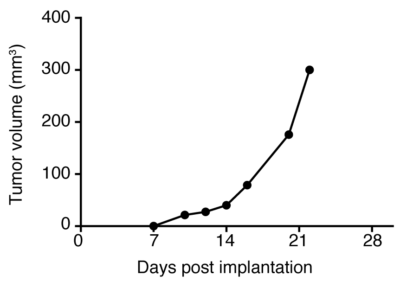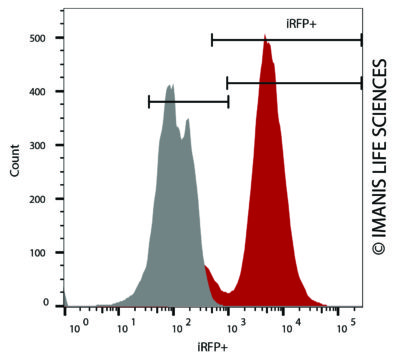B16F10-iRFP-Puro
| Species | Mouse |
| Cell Type | Melanoma |
| Transgene | Near-infrared fluorescent protein (iRFP; ex/em 690/713 nm) |
| Selection Gene | Puromycin resistance (Puro) |
-
Description
B16F10-iRFP-Puro is a polyclonal population of the murine melanoma cell line B16F10 (ATCC® CRL-6475™). To achieve stable reporter expression in the polyclonal population, parental B16F10 cells were transduced with LV-iRFP-P2A-Puro (LV032) and selected using puromycin. LV-iRFP-P2A-Puro encodes the near-infrared fluorescent protein (iRFP) cDNA linked to the puromycin resistance gene (Puro) via a P2A cleavage site (P2A) under the spleen focus-forming virus (SFFV) promoter.
*The ATCC trademark and trade name and any and all ATCC catalog numbers are trademarks of the American Type Culture Collection.
This cell line has been tested for mycoplasma contamination and is certified mycoplasma free.
The parental B16F10 cell line has been authenticated and certified free of interspecies cross contamination by short tandem repeat (STR) profiling with 9 STR loci.
Due to the immunogenicity of the reporter genes in this cell line, we recommend using immunocompromised mice for in vivo studies.
-
Characterization
In vivo Imaging
 A C57Bl/6 mouse was implanted with 5 x 105 B16F10-iRFP-Puro (CL099) cells in the right hind flank. Tumor growth was monitored over time using calipers.
A C57Bl/6 mouse was implanted with 5 x 105 B16F10-iRFP-Puro (CL099) cells in the right hind flank. Tumor growth was monitored over time using calipers.Morphology
 Low and high density cell morphology (200x)
Low and high density cell morphology (200x)iRFP Expression
 B16F10-iRFP-Puro (red) or control (B16F10; grey) cells were fixed with paraformaldehyde and analyzed by flow cytometry (20,000 events).
B16F10-iRFP-Puro (red) or control (B16F10; grey) cells were fixed with paraformaldehyde and analyzed by flow cytometry (20,000 events). -
Growth Conditions
Complete Growth Medium: DMEM supplemented with 10% FBS, 1X Penicillin/Streptomycin, and 1 µg/mL puromycin.
The addition of puromycin to the complete growth medium maintains high reporter expression over continued passage of the cells. It is highly recommended, especially if the cells undergo multiple passages prior to being used for studies.
These cells should be grown in the indicated medium and passaged when they reach confluency. For routine passaging, cells are recommended to be split at a 1:10 ratio every 3-4 days.
B16F10 cells produce melanin; accumulation of melanin turns the cells dark brown or black and prolonged melanin secretion turns cell culture medium black. Melanin is toxic and B16F10 cells will die in the presence of excess melanin. Culture medium should be changed as soon as it becomes black, even if the cells are not confluent. Typically, media changes between passages are not required. Different lots of FBS have been observed to affect the rate of melanin production by B16F10 cells.
B16F10 cells trypsinize relatively quickly. Excess trypsinization can damage the cells and care should be taken to quickly neutralize the trypsin upon cell detachment.
-
Usage Information
These cells are suitable for in vitro and in vivo experimentation. B16F10 cells form tumors and pulomary metastases post implantation into syngenic C57BL/6 mice.1 The iRFP transgene facilitates in vivo and ex vivo fluorescence imaging of implanted cells. To reduce background autofluorescence, mice should be fed an alfalfa-free diet for at least a week prior to imaging.
The cells can be amplified in vitro and used to generate additional frozen stocks. Cryopreservation of low passage stocks is recommended. Frozen stocks should be preserved in a designated cryopreservation medium.
These cells were generated via lentiviral vector transduction. The lentiviral vector used for transduction was a self-inactivating (SIN) vector in which the viral enhancer and promoter have been deleted. Transcription inactivation of the LTR in the SIN provirus increases biosafety by preventing mobilization by replication competent viruses and enables regulated expression of the genes from the internal promoters without cis-acting effects of the LTR2. Nevertheless, all work with these cells should be performed under biosafety-level 2 (BSL2) conditions by trained personnel. Institutional requirements may permit handling of these cells under BSL1 conditions if certain criteria are met.
References:
1Fidler. Cancer Res. 1975. 35:218-224.
2Miyoshi et al. J Virol 1998. 72:8150-8157. - Datasheet/COA